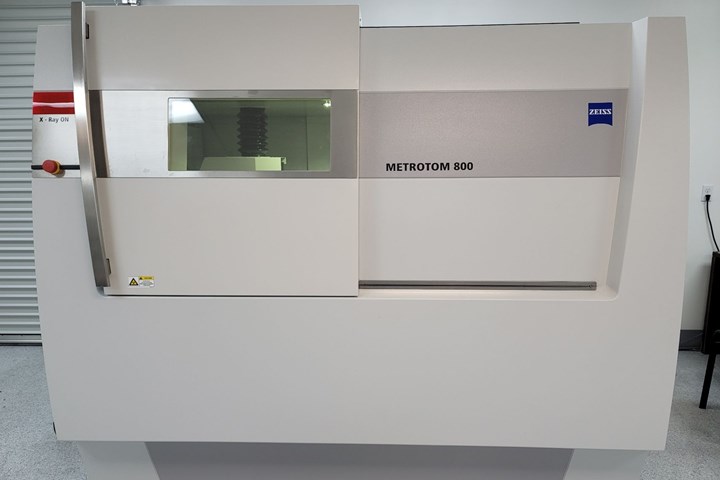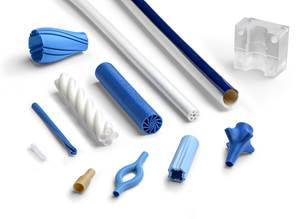The Zeiss MetroTom 800 computed tomography (CT) scanner is not the only investment in technology and people Trademark Plastics Inc., Riverside, Calf., has made since embarking on its five-year plan in 2017, but it’s definitely one that Bryan Barrera, chief operating officer, enjoys talking about. When asked about his pending scanner installation, Barrera enthuses, “This is a really cool subject,” before expanding on the myriad benefits the machine would provide Trademark’s first-article medical -omponent validations, and how it would be integrated into its dedicated inspection lab. After several minutes of praise for the new instrument, Barrera catches himself: “I’m going to shut up now, because I feel like I’m going off.”

Trademark Plastics is using a Zeiss MetroTom 800 CT scanner to optimize its first-article validation process as a medical molder, and to inspect molded parts in process.
On that topic, and anything else related to reinvesting in its facility and its people, Barrera and Trademark have a lot to talk about. Barrera estimates that the company has spent $2 million on capital equipment over the last couple of years, plus another $1 million on Trademark’s “human capital,” as Barrera calls its employees. The latter investment has come in the form of training at RJG and Beaumont’s American Institute of Molding, individual quality certifications in ISO 13485 and Six Sigma, and continuing education. Trademark picked up the tab on Barrera’s MBA from Pepperdine University and is currently funding his work towards a PhD.
“For the last few years, we’ve been focusing on rebranding ourselves,” Barrera says. “We’ve also focused a lot more on our customers and becoming an extension of our customers.” The focus on customers and efficiency has paid off. In 2017, Barrera says Trademark had a banner year, generating $22.7 million in revenue from more than 230 employees. In 2020, Trademark had $21 million in sales revenue, produced with only 136 employees. A portion of the leaner workforce and greater efficiency was intentional, much of it, like a lot of things that happened in 2020, was not.
“We ran very lean pre-COVID,” Barrera says, “but once COVID hit, it’s been very difficult for us to get the resources that we need, so we’ve been forced to get into automation even further, and this new CT Scanner is really going to revolutionize the way we do our business.”
“For the last few years we’ve focused a lot more on becoming an extension of our customers.”
Barrera says with the new scanner, good manufacturing practice (GMP) medical validations that formerly took two to three weeks to complete using statistical process control (SPC) per installation qualification, operational qualification, and performance qualification (IQ, OQ, PQ) will now take only one day each. In 2020, Trademark did more than 75 validations, becoming more and more experienced, but still not proficient enough, prompting a visit to metrology equipment supplier Zeiss. “I went to Zeiss with our continuous-improvement manager and said, ‘I really need to automate this validation process even further; we spend way too much time in inspections,’” Barrera recalls.

Five new Wittmann Battenfeld Cartesian robots were among the equipment additions Trademark made in 2020.
On a whim, the Zeiss representative showed Trademark one of its more expensive systems—not expecting that Trademark would actually buy it—but Barrera and his team were more than impressed, though wary about the price tag. “I asked this guy, ‘How much is this—like $1 million, half a million?’ and he was like, ‘It’s up there—it’s not $1 million—but it’s up there.’”
Trademark sent Zeiss full-shot samples of some of its toughest products to inspect, and after developing a program, which took a couple of days, the MetroTom 800 was able to measure a seemingly endless amount of dimensions in only 7 min. “It’s able to read more than 200 dimensions at a time, which is insane,” Barrera says. “So this process that takes us like two weeks to do 30 shots—you can do one shot every 6 or 7 min. We were just floored.”
“The scanner is going to map the part out for us, and it’s going to tell us what’s inside the part.”
In addition to sending its validation process into warp drive, the CT scanner can be used for in-process inspection, letting Trademark see inside parts to catch flaws that aren’t visible on the part’s surface, just after molding. “We can have our most seasoned veterans grab some parts in process and put them into the MetroTom,” Barrera says. “The scanner is going to map the part out for us, and it’s going to tell us what’s inside the part—you can see voids and cracks that are not visible to the naked eye.”
Smarter Packaging
The changes in Trademark’s quality operations have had an impact that ripples throughout the entire plant, with efficiencies building upon themselves and maximizing employee value as they spread. The new and improved inspection process will allow members of the quality team to cross-train and add packing to their tasks. Packing itself became more automated at Trademark with the addition of automated tape machines procured through equipment supplier representative Hirate America. Two years ago, Barrera says Trademark utilized three packers per shift solely for packaging products. After introducing the automated tape machines, the company now utilizes the equivalent of half an operator per shift.
The decision to add the automated tape equipment came after a visit to a customer where Barrera says one element typically seen on the plant floor was conspicuously absent. “I told the customer, ‘I’ve been here for two hours, and I haven’t seen anybody on these machines,’” Barrera remembers, “and the customer said, ‘That’s the point.’”

Addition of indexing conveyors allowed Trademark Plastics to have fewer operators managing more molding machines simultaneously.
Without the automated machine, workers used to tape and move boxes manually, stacking them in different sections. The new taping equipment features a laser that adjusts to the size of the box. Now, when product is ready, boxes of parts are sent through the automated tape machine, which tapes the top. The boxes are then flipped over and filled with product.
“We want to be able to help customer with product development.”
On the same visit, Barrera took notice of the customer’s use of indexing conveyors on every single machine and decided to copy that, too. Today, at Trademark Plastics, as parts are molded, a Wittmann Battenfeld robot (Trademark added five of them in 2020) puts them onto the indexing conveyor, which holds up to four bins. As the bins fill, the conveyor advances, minimizing the need for worker intervention. “It makes it a lot easier for our team to just grab a shot before it goes into the bin or take one off the conveyor and start measuring parts for in-process inspection,” Barrera says. “Before, our operators were still able to manage the machines in a stressful environment. Now they can handle four or five machines without stress, because the indexing conveyor is doing all the work until it’s time to package, and there we have the automated tape machine.”
Better Handle on Materials Handling
Already wringing greater efficiency from its inspection and parts handling/packaging, Trademark again turned to Wittmann Battenfeld for automation to optimize its material handling. Trademark, processes nearly 4 million lb of resin annually, molding 500 million parts in 2020 from 52 machines ranging in clamp force from 7 to 500 tons. The company operates four molding rooms in its 100,000-ft2 plant, with two white rooms—the larger one housing 20 machines—plus Class 7 and Class 8 cleanrooms, each with 13 presses. Prior to investing in a Wittmann centralized material handling system, all these rooms were islands unto themselves when it came to managing resin.

Trademark has multiple white-room and cleanroom molding areas, including this Class 7 cleanroom.
“We’d have an issue with one cleanroom shutting down because of the loading system,” Barrera says, “so we’d have to shut that down, and then, maybe a week later, we’d have to shut down the other room—it was just all over the place.” Exacerbating the problem was difficulty in staffing that particular department. “The toughest position for us to retain here is material handling,” Barrera says. “We have some really loyal materials people that are good, but it’s tough to get fully staffed, so I’m trying to automate that as much as possible.” In addition to the new loading system from Wittmann Battenfeld, Trademark also added beside-the-press granulators through Hirate. “Before, we had an independent system in each room, but everything’s integrated now. With Wittmann, one system notifies you.”
Beyond upgrades to its inspection, automation, and material handling, Trademark has also partnered with FimmTech (Carlsbad, Calif.) to utilize its Nautilus process development and mold qualification software. Created by Suhas Kulkarni and based on scientific molding and Design of Experiments (DOE) principles, Nautilus can help “automate” process development.
“So we do a lot more DOEs,” Barrera says. “Through [Nautilus] software, and we have a really, really stringent technical process engineer program.”
Stick to the Plan
In 2017, the first year of Trademark’s five-year plan, the focus was on better understanding its business and investing in human capital. Year two was about focusing on efficiencies, and in year three the emphasis was boosting sales, which indeed jumped $6 million. In 2021, year four, expansion is the key, and to that end, Trademark is looking to expand into Mexico for assembly operations and to build another cleanroom at Riverside. What’s next? “Year five, the goal is to start getting ready to do product development,” Barrera says. “We want to be able to help customers with product development. So far we’re on track and in some areas, we’re ahead of schedule.”

Trademark Plastics has deployed robots and indexing conveyors on its presses to increase efficiency.
Related Content
Catheter Specialist Finds Sweet Spot Serving Small, Medium-Sized Concerns
Medical-component specialist LightningCath has carved a niche meeting the needs of small to medium-sized entrepreneurs with complex catheter designs … quickly.
Read MoreIndustrial Resin Recycling Diversifies by Looking Beyond Automotive
Recycler equips for new business in medical, housewares and carpeting.
Read MoreCompact Solution for Two-Component Molding
Zahoransky’s new internal mold handling technology foregoes the time, space and money required for core-back, rotary table or index plate technologies for 2K molding.
Read MoreDuPont Buys Medical Product Manufacturer Spectrum Plastics
Purchase price of $1.75 billion for leading supplier of extruded, molded, and 3D printed medical components.
Read MoreRead Next
How COVID-19 Did (and Didn’t) Change Automation in Plastics
The global pandemic invigorated longstanding trends and new market forces to push broad-based adoption of automation and robotics from the incremental to the inexorable.
Read MoreMachinery & Robot Developments at Wittmann Battenfeld
Open house celebrates expanded U.S. headquarters & showcases innovations.
Read More














